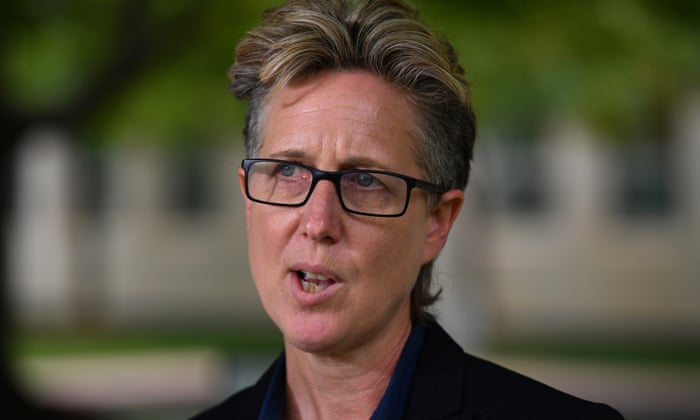
Australian government ‘recognises concern’ over monkeypox following WHO declaration
The department of health has just issued a statement on the monkeypox outbreak, which was declared as a global public health emergency by the World Health Organisation overnight.
The department said:
The Australian Government recognises the concern in the gay, bisexual and other men who have sex with men community about this virus and we are working across governments to respond.
The Department of Health and Aged Care’s National Incident Centre has been activated and is working closely with the states and territories, through the Australian Health Protection Principal Committee and its subcommittees, to coordinate a national response to monkeypox.
On 23 July 2023, the World Health Organization (WHO) declared Monkeypox a Public Health Emergency of International Concern (PHEIC) and provided recommendations to countries to respond.
Australia has been implementing an enhanced nationally coordinated response since May 2022, and has already progressed activities to address the WHO recommendations.
As with any infectious disease, state and territory Public Health Units are responsible for patient management and clinical support, as well as implementing any transmission prevention and control measures, such as isolation.
National expert groups have developed guidelines for monkeypox treatment and vaccination; infection prevention and control; and case and contact management. This is available here Monkeypox (MPX) | Australian Government Department of Health and Aged Care
In addition, on 1 June 2022, ‘monkeypox virus infection’ was listed for an initial 6 months on the National Notifiable Diseases List (NNDL) to enable better reporting and data sharing.
The Department of Health and Aged care is working closely with peak bodies and organisations to improve awareness and encourage people at risk and health professionals to be aware and alert to the symptoms.
An MPX vaccine (ACAM2000®) and a treatment are available in the National Medical Stockpile. State and Territory Governments can access these treatments on a request by the Chief Health Officer or their delegate. The Australian Government will continue work with the states and territories to investigate all options to manage any monkeypox outbreaks within Australia, such as emerging treatments and vaccines.
Key events
The children have taken over in Canberra.
Australia records 44 cases of monkeypox
Just another update on monkeypox.
The most recent data we have shows there have been 44 cases in Australia.
That data is current as of Saturday, 23 July, and has been provided by the health department.
The state and territory breakdown of cases is as follows:
- NSW – 24
- Vic – 16
- ACT – 2
- QLD – 1
- SA – 1
The vast majority of the 44 cases have been acquired overseas. A small number have been acquired locally.
Australian government ‘recognises concern’ over monkeypox following WHO declaration
The department of health has just issued a statement on the monkeypox outbreak, which was declared as a global public health emergency by the World Health Organisation overnight.
The department said:
The Australian Government recognises the concern in the gay, bisexual and other men who have sex with men community about this virus and we are working across governments to respond.
The Department of Health and Aged Care’s National Incident Centre has been activated and is working closely with the states and territories, through the Australian Health Protection Principal Committee and its subcommittees, to coordinate a national response to monkeypox.
On 23 July 2023, the World Health Organization (WHO) declared Monkeypox a Public Health Emergency of International Concern (PHEIC) and provided recommendations to countries to respond.
Australia has been implementing an enhanced nationally coordinated response since May 2022, and has already progressed activities to address the WHO recommendations.
As with any infectious disease, state and territory Public Health Units are responsible for patient management and clinical support, as well as implementing any transmission prevention and control measures, such as isolation.
National expert groups have developed guidelines for monkeypox treatment and vaccination; infection prevention and control; and case and contact management. This is available here Monkeypox (MPX) | Australian Government Department of Health and Aged Care
In addition, on 1 June 2022, ‘monkeypox virus infection’ was listed for an initial 6 months on the National Notifiable Diseases List (NNDL) to enable better reporting and data sharing.
The Department of Health and Aged care is working closely with peak bodies and organisations to improve awareness and encourage people at risk and health professionals to be aware and alert to the symptoms.
An MPX vaccine (ACAM2000®) and a treatment are available in the National Medical Stockpile. State and Territory Governments can access these treatments on a request by the Chief Health Officer or their delegate. The Australian Government will continue work with the states and territories to investigate all options to manage any monkeypox outbreaks within Australia, such as emerging treatments and vaccines.
Survey: one in three apartment buyers seeing builder go broke
Apartment buyers are demanding a shake-up in insurance protection from broke builders who leave them high and dry.
A survey by industry body Australian Apartment Advocacy of 1,100 apartment buyers from around the country shows one in three had seen their original builder go broke in the past 12 months.
This left many stranded with no builder warranty or insurance to fix defects.
Under current legislation and regulations in most states, if an apartment owners’ builder goes bankrupt they only get assistance if their complex is three storeys or below.
Latest Australian Bureau of Statistics data shows 50% of apartment owners live in buildings four storeys or higher.
Australian Apartment Advocacy head Samantha Reece said the report, released on Sunday, showed buyers were understandably furious.
She called on state governments around the country to act.
– From AAP
Traditional owners say they are being ‘railroaded’ over WA rock art site
Traditional custodians behind a push to halt construction of a fertiliser plant on the Burrup peninsula that would require the removal of Indigenous rock art say they have been given just three days to respond to a 180-page document.
Construction work on the $4.5bn urea plant planned by multinational company Perdaman has been paused for 30 days while the federal environment minister, Tanya Plibersek, considers a request to intervene to protect ancient petroglyphs.
At least three sites of significance would need to be relocated as part of construction of the plant at the heavy industry hub on Western Australia’s north-west coast.
However, in a statement released on on Sunday, Raelene Cooper, a Mardudhunera woman and former chair of the Murujuga Aboriginal Corporation, and Josie Alec, a Kuruma Mardudhunera woman from the group Save our Songlines, said the Department of Environment was “railroading” traditional owners:
We received an email from the department on a Saturday night without any prior notice demanding we respond to hundreds of pages of submissions within 72 hours across the weekend.
We are traditional custodians, not a big industry multinational with a team of corporate lawyers.
This feels like just more railroading of traditional custodians without proper consultation or free, prior and informed consent. Given the minister’s public comments this week, we had hoped for better, but yet again our Indigenous voices are being silenced.
We again renew our invitation to the minister to visit Murujuga to understand our cultural heritage while she considers her decision.
Unions welcome winding down building commission
More unions have welcomed Labor’s plan to strip the Australian Building and Construction Commission of much of its power within days.
The workplace relations minister, Tony Burke, announced on Sunday that the powers of the ABCC would be stripped back to the “bare legal minimum” from Tuesday. Labor is still pushing to abolish the ABCC entirely later this year.
According to AAP, CFMEU spokesman Dave Noonan said the building code, enforced by the ABCC, was the “last of a series of anti-union policies enacted by successive Liberal governments”.
The code as enforced by the ABCC has failed to address the big issues confronting the industry such as workplace fatalities and injuries, wage theft and the exploitation of visa workers.
The Electrical Trades Union national secretary, Michael Wright, said scrapping the building code was a “no-brainer”.
Smoke-alarm call after fatal Sydney house fire
NSW Fire and Rescue has released a statement about the horrific fire in Sydney’s south-west that killed three people this morning.
They’ve used it to reiterate that smoke alarms save lives.
Nearly 50% of the homes impacted by fire this winter have not had a working smoke alarm.
We are asking all residents to take action and to check their smoke alarms today, and if you have questions about what’s required, contact your local fire station.
Three people, including a child, have died and three others have been seriously injured in a house fire in Sydney’s south-west this morning.
Shortly after 5.30am, Fire and Rescue NSW (FRNSW) responded to a property well alight at the intersection of Rottnest Avenue and Nicol Place in Hinchinbrook.
Upon arrival, firefighters immediately began attacking the flames.
FRNSW crews used ladders to access the upper level of the two-storey home, forcing entry in extreme fire conditions and pulling a number of people to safety.
NSW Ambulance paramedics treated all six occupants at the scene. Two women – believed to be aged in their 40s and 60s – were pronounced dead at the scene.
Four others were transported to hospital, where one of them, a 10-year-old boy, died late this morning. The other patients included a man in his 40s, who remains in a critical condition, and two women in their 30s and 60s who are in stable conditions.
Two firefighters were also treated for injuries as a result of their actions fighting the fire. One had sustained a minor electric shock, while another had fallen from the upper level of the home.
FRNSW investigators are on-scene, assisting NSW police forensic officers in determining the cause and origin of the fire.
FRNSW has responded to more than 500 residential fires since 1 June.
Tragically, 13 people have lost their lives in fires so far this winter – nine more fire fatalities than all of last winter.
Fifty fire-related injuries have also been reported.
Superintendent Adam Dewberry from FRNSW said: “Smoke alarms save lives.”
Nearly 50% of the homes impacted by fire this winter have not had a working smoke alarm.
We are asking all residents to take action and to check their smoke alarms today, and if you have questions about what’s required, contact your local fire station.
Perrottet on Barilaro inquiry
Sticking with the NSW premier for a moment. He has told reporters that any document relevant to the inquiry into John Barilaro’s appointment to a lucrative New York trade post should be provided as soon as possible.
Speaking in Japan, Dominic Perrottet was asked about the use of standing order 52, which upper house MPs are using to compel the state government to hand over documents about the affair.
According to AAP, he said:
My view is that any document [to the inquiry] that should be legally provided needs to be provided as quickly as possible.
Dates are set and they should be met.
There’s a whole lot of SO-52 [standing orders] that have been issued and my expectation is they should be complied with.
Perrottet repeats call for Warragamba dam to be raised
The New South Wales premier, Dominic Perrottet, once again called for the Warragamba dam to be raised during a visit to a world-leading flood mitigation facility in Japan.
Wrapping up the first leg of his 10-day Asian trade tour on Sunday, Perrottet visited the Ryu-Q Kan facility, one of the world’s biggest underground drainage channels, on the outskirts of Tokyo.
Located 50m below ground, the Metropolitan Area Outer Underground Discharge Channel acts as a mammoth water-storage tank to protect Tokyo from flooding during Japan’s monsoon rains.
Completed in 2006 at a cost of more than $2bn, its 177m-long underground surge tank has a capacity of 2.5 gigalitres.
It collects overflowing water from four rivers and makes controlled, safe releases to the Edo River.
In comparison, the Warragamba Dam in western Sydney can hold some 515 gigalitres per day.
Perrottet praised the engineering effort as “world-leading” but said a similar facility in Sydney would need to be 400 times the size of the underground drain to deal with floods on the scale of those that recently ravaged the state.
The premier said raising the walls of the Warragamba Dam would cost about $1.6bn and he called on the federal government to fund half of the proposed work.
Raising the Warragamba Dam will provide incredible support to reduce flooding downstream. We know that to be true.
However, some experts don’t believe the proposed five-year project will fully solve Sydney’s flood problems.
Other suggestions include improving flood evacuation routes for communities and moving people off flood-prone land through government land buybacks.
Asked about flood plain buybacks, Perrottet would not rule anything out, saying: “Everything is on the table.”
Insurance Council welcomes NSW opposition’s flood-proofing plan
The Insurance Council Australia chief, Andrew Hall, has welcomed $225m plan by New South Wales Labor to flood proof western Sydney.
The Western Sydney Floods Resilience Plan announced on Sunday by the Labor opposition leader, Chris Minns, includes $24m for new levees at Peachtree Creek, McGraths Hill and Pitt Town.
Today’s announcement by New South Wales Labor is a welcome first step and shows that political stakeholders are heeding the resilience message insurers have been giving over a long period.
New South Wales is the highest-taxing state in the country when it comes to insurance, which drives down adequate coverage at a time and in a state where we need it most.
In the lead-up to next March’s state election, the Insurance Council and insurers are calling on all parties to commit to abolishing this retrograde impost.
The February-March 2022 floods caused $4.8b in insured losses – half of which were in NSW – making the event the most costly flood ever.
ACTU welcomes stripping of building commission’s powers
The ACTU secretary, Sally McManus, has welcomed the Labor government’s decision to wind down the Australian Building Construction and Commission.
The employment and workplace relations minister, Tony Burke, announced on Sunday that the Albanese government would strip the ABCC of its powers and hand its oversight to other regulators.
McManus said the ABCC and requirements under the building code introduced by the Coalition were “anti-worker, onerous and non-sensical”, calling it a “relic” of the “divisive years” under the Turnbull government that lead to an infamous double dissolution election.
We welcome the removal of the anti-worker aspects of the building code as the first and important steps to the Albanese government implementing their election commitment to abolish the ABCC and its underpinning legislation.
The code was one of the ideological projects of the previous government, who spent nearly a decade attacking unions and suppressing wages.
Instead of acting to address important issues like increasing the number of permanent jobs by stopping excessive casualisation or fixing our broken bargaining laws so workers could get pay rises, they spent their time undermining workers’ rights.
It stopped progress on apprenticeships and skills in the construction industry and did nothing to address safety or wage theft. Taxpayers’ money was wasted on banning the Eureka flag and policing union posters on noticeboards.



